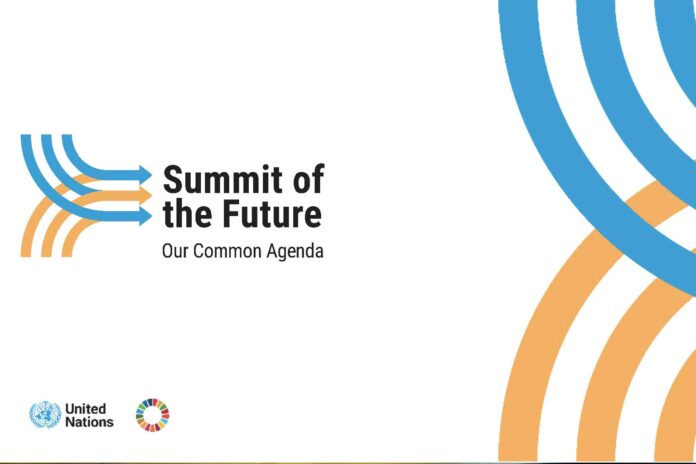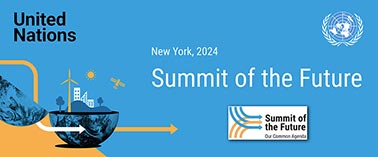Last year, the United Nations (UN) SDG Summit in September 2023 marked the halfway point to the 2030 Agenda – for the 17 Sustainable Development Goals. The SDG Summit adopted the SDG Political Declaration, in which world leaders reaffirmed their commitment to the Goals and expressed concern over the lack of progress to date, with just 17% of SDG targets on track.
After the SDG Summit in 2023, the UN is now gearing up for the once in a generation Summit of the Future, with an unprecedented number of world leaders set to attend the Summit.
The Summit of the Future: Multilateral Solutions for a Better Tomorrow was first proposed by UN Secretary-General António Guterres in his Our Common Agenda report in September 2021. The report was his response to a call from Member States for ideas on how better to respond to current and future challenges.
The Summit has been called by Guterres as a “once in a generation opportunity to reinvigorate global action, recommit to fundamental principles, and further develop the frameworks of multilateralism so they are fit for the future”.
The UN says that if the 2030 Agenda, the Paris Agreement and the Addis Ababa Action Agenda (among others) were the “what” in terms of goal setting and commitments, the Summit of the Future will be the “how”: How can we work together effectively to meet those targets and tackle the most pressing issues, while preparing for a more resilient future?
When the 2030 Agenda was formulated in 2015, artificial intelligence and other emerging digital technologies were still nascent, so the Summit of the Future will address the potential and challenges they present and develop the tools to “turbocharge the SDGs”.
Among other things, this means renewing or fine-tuning multilateral systems of governance to ensure the 43 points agreed in the SDG Summit’s Political Declaration are advanced.
The outcome will be a Pact for the Future negotiated and endorsed by UN Member States in the lead-up to and during the Summit in September 2024.
Why is the Summit important?
In 2024, the climate crisis continues to bring record-breaking extreme weather events that have affected millions of people across the globe – with a disproportionate impact on less developed countries.
Research estimates more than 15,000 people were killed in Africa by extreme weather in 2023, which affected 34 million lives.
Between 1970 and 2021, 11,778 disasters have been attributed to weather, climate and water extremes. They caused more than two million deaths and $4.3 trillion in economic losses, according to the World Meteorological Organization (WMO) and multi-agency United in Science 2023 report.
The climate crisis is the biggest global risk over the next 10 years, and is deeply interconnected to other major geopolitical, societal and economic global risks, including conflict, infectious diseases and the cost-of-living crisis.
Climate change impacts the world’s ability to meet the Agenda 2030 SDGs: from Goal #2 Zero Hunger, as crop failure threatens food security, to Goal #14 Life Below Water as warming seas threaten marine ecosystems and the livelihood of humans that rely on them.
But humans can change the course of the climate crisis. The UN declared 2024 to 2033 as the International Decade of Sciences for Sustainable Development.
Scientific solutions can “supercharge” progress towards the SDGs, the WMO says, including the use of weather predictions to boost food production and early warning systems to limit the impact of extreme weather events.
The world has made notable progress in key areas, including climate action, the UN said, following the July 2024 HLPF. Renewable energy consumption rose from 16.7% in 2015 to 18.7% in 2021; HIV infections dropped 27% from 2015 to 2022; child mortality under five hit a historic low of 4.9 million in 2023; and internet access now reaches 95% of the global population, a 70% increase over eight years.
What will the Summit present?
UN Member States have agreed the Summit of the Future will be centred around five key targets:
1. Reaffirm the UN Charter
2. Reinvigorate multilateralism
3. Boost implementation of existing commitments
4. Agree on solutions to new challenges
5. Restore trust.
In February 2023, Guterres released 11 policy briefs offering “concrete ideas” on how to advance Our Common Agenda as Member States prepare for the Summit.
These are:
- The needs of future generations
- Improving the international response to complex global shocks through an emergency platform
- More systematic participation by young people in decision-making processes
- Metrics that go beyond gross domestic product
- Global digital cooperation on maximizing and sharing the benefits of digital technology through a Global Digital Compact
- Reform of the global financial architecture
- The peaceful, secure and sustainable use of outer space
- A New Agenda for Peace
- Information Integrity
- Transforming Education: achieve a fundamental shift in how education is seen and treated including its purpose; the learning environment; the teaching profession; harnessing digital transformation; investing in education
- UN 2.0: adapt basic UN practices on data, communications, innovation, strategic foresight, performance and results, and more, so it is better positioned to support all the above and face the challenges of tomorrow.”










